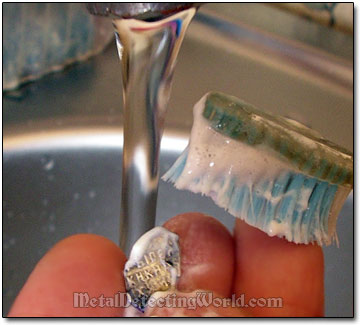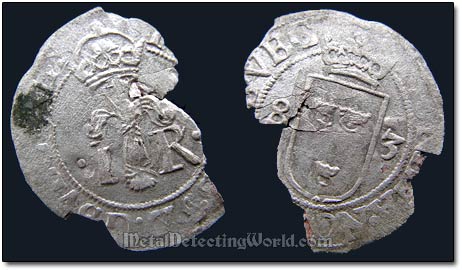Cleaning Silver Coins - Tutorial, page 3
Simple and Quick Method for Brightening Silver Coins of Silver Content Higher than 0.203
(...CONTINUED from previous page)
NOTE 1 - Preventing Appearance of Pure Copper on Coins of Low Silver Content:
Always make sure you have enough of lemon acid solution in the container with coins. This may be important if you are treating silver coins of low silver content, and they have other admixtures besides copper in their alloys. Copper content is evidenced by appearance of copper sulfate encrustation on dug coins' surfaces.
During the process of dissolving copper salts, the products of chemical reactions are copper citrate, oxygen and carbon dioxide. While the bubbles of oxygen and carbon dioxide leave the solution, the copper citrate stays in the solution; thus, its concentration is increasing. As copper salts get dissolved, the concentration of copper citrate reaches a certain high point.
If the immersed silver coin has a low silver content, with zinc present in the coin metal (a rare case in silver coins but still a possibility), the following is more likely to happen. As the fast disappearing copper salts expose more and more copper, copper citrate begins to react with zinc in the alloy.
Because zinc is more active than copper, a redox (oxidation and reduction) chemical reaction begins. As a result of this reaction, pure copper begins to appear in form of pink crystals at the spots where copper sulfate was present not long ago. These pink fissured stains certainly make the coin unattractive.
Unlike the silver coins, the copper coins are more likely to be damaged by this process when they are immersed into the lemon-acid solution. To avoid this problem, a large amount of solution is used, and the solution should be changed a few times during the process.
4) Brush Your Coin with a Toothbrush and Toothpaste
Now it is important to clean the gray-bluish substance off the coins' surface. This substance is the combined product of chemical reactions between Lemon Acid and Silver Tarnish, and between Lemon Acid and copper salts. Brushing with toothpaste effectively gets the job done, followed by rinsing with water.

Brushing a Silver Wire Hammered Coin with Toothpaste
After the coins are rinsed with water and dried with napkins or cloth, they are ready to be displayed.

A Silver 1583 ½ Öre Coin Has Been Cleaned
If there are still some dark spots of tarnish, like a dark spot at 10 o'clock on the coin's obverse shown on a picture above, remaining on the coin after cleaning with this method, use the most effective Electrochemical Reduction Cleaning Method for Tarnished Silver Coins to remove them.
NOTE 2 - Preservation of Silver Coins:
As silver is tarnished by hydrogen sulfide (gaseous) in the air, silver coins will turn dull again over time, usually within a month, if not protected. To avoid their tarnishing, you can either keep the coins in cellophane or polyvinyl chloride bags or to cover them with oils that are especially designed for preserving coins. If such oil (sold in any coin collector's shop) is not readily available, you can "shield" your coin with mineral or olive oils (you can find more information on preservation of coins useful Tips for Cleaning Coins).
Ideally, you should keep your silver coins in a low-humidity environment. You can place a small bag of activated charcoal or a piece of chalk in your "coin-drawer" to minimize future tarnish. If you do not want to bother with preserving your silver coins, their appearance can be easily restored by rubbing them with a soft eraser.
Happy Hunting!
If you would like to learn other effective methods for cleaning silver coins, please visit Other Methods for Cleaning Silver Coins.
To learn my simple and effective method for cleaning copper coins, please visit Effective Method for Cleaning Copper Coins.
Make a Donation
Please help me stay afloat, afford more metal detecting trips with field-tests and experiments to create more informative articles, useful tutorials and helpful guides for detectorists, and maintain this website - the most informative hobby resource on the web! Since I do not have any steady income, any donation matters to me a lot! Thank you kindly!
Clicking on the donate button will take you to a donation page powered by Donorbox and dedicated to my website (MetalDetectingWorld.com). The donation page is PCI-compliant, secured by SSL/TLS, and has a simple form to fill out. Donorbox does not store any card or bank data. Credit card information is encrypted and tokenized by the Stripe payment processor.
This website would not exist without the advertisements we display and your kind donations. If you are unable to support us by viewing our advertisements, please consider making a Donation to ensure the future of this website. By helping me keep this website alive and growing, you will sure help many detectorists around the world as well!
ANNOUNCEMENT:
In January of 2020, I started a one-time fund-raising campaign in attempt to accumulate enough money to buy a simple but reliable 4x4 vehicle. My old 4x4 car (made in 1995) had faithfully served me for 10 years before it eventually went beyond repair last October. Without a 4WD, I will not be able to get to my hunt sites and test-plots hidden in the remote wooded areas inaccessible by a regular car.
Unlucky for me, those sites are the only locations available and suitable for my field-work which results in informative articles you can find on this website. For the past 10 years, my usual field-work has consisted of field-testing the latest metal detectors and accessories, experimenting with some of them, and devising new effective search methods that meet the requirements of the new metal detecting reality.
Before my car died, I managed to finish a couple of interesting detector-testing projects which will be covered in my upcoming articles. But other equally important projects that I was working on were not completed and had to be postponed until the Spring 2020. I hope that this fund-raising campaign will help me get a decent 4x4 by then so that I will be able to resume my work and to write more new articles, tutorials and guides based on data gathered through testing and experimentation.
If you find my website useful and would like it to provide more essential info for you and other detectorists worldwide, please consider chipping in $5, $20, $50 or whatever you can afford to keep MetalDetectingWorld.com growing in 2020. I promise you, it will be money well spent. Thank you.
DonateIf you would like to point out any errors, ask me a question, express your opinion, suggest a new idea, or submit your cleaning method, please do not hesitate to send me a message!
Back to 'Cleaning Silver Coins page 16'
A Complete Guide to Coin Cleaning
- Please help me promote this tutorial:
If you would like to follow me on Twitter, please press a button:
I have my profile page on
where you can share your thoughts on this tutorial, ask me a question, or place a friend request.I also have my profile pages on Pinterest, LinkedIn, Tumblr, Reddit and Delicious
and my "Metal Detecting World" page on Twitter, Pinterest and Tumblr
I no longer maintain my old Facebook page